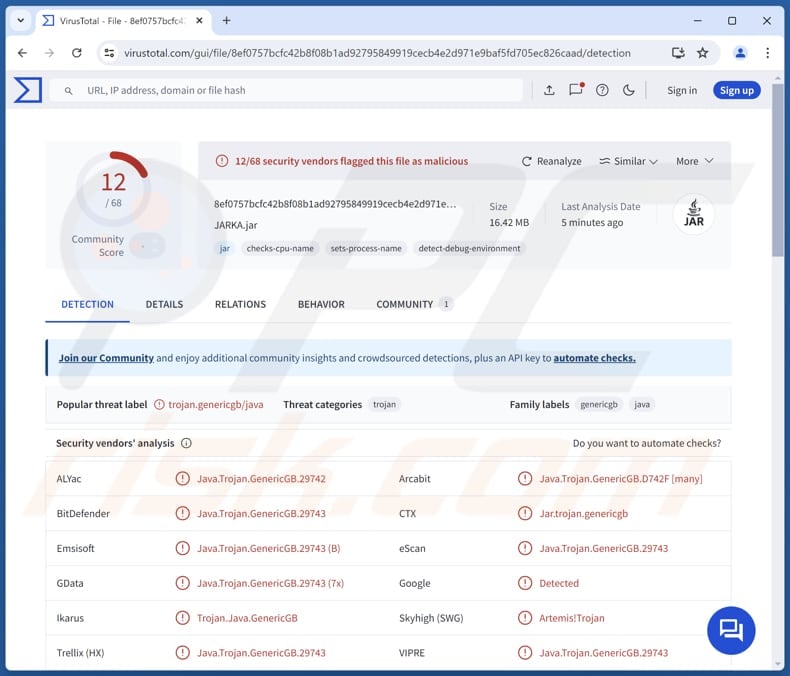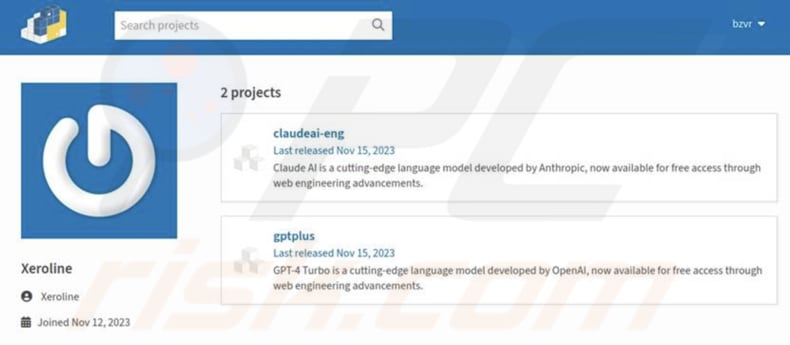How to remove JarkaStealer from the operating system
TrojanAlso Known As: JarkaStealer information stealer
Get free scan and check if your device is infected.
Remove it nowTo use full-featured product, you have to purchase a license for Combo Cleaner. Seven days free trial available. Combo Cleaner is owned and operated by RCS LT, the parent company of PCRisk.com.
What kind of malware is JarkaStealer?
JarkaStealer is an information stealer distributed using malicious packages for artificial intelligence (AI) integration. It targets browsers and other applications and can also take screenshots. To avoid potential risks, JarkaStealer should be eliminated from infected systems as soon as possible.

More about JarkaStealer
One of JarkaStealer's key features is its ability to steal sensitive information from various web browsers. It can extract login credentials (e.g., usernames and passwords), cookies, and other personal data stored within the browser. Once stolen, this data can be used for identity theft, unauthorized account access, or sold on the dark web.
Furthermore, JarkaStealer can capture screenshots. This allows the malware to monitor the victim's activities, including sensitive information being entered on the screen (e.g., credit card details, ID card information, and social security numbers). These details can also be misused for malicious purposes.
JarkaStealer can also steal session tokens from a range of applications, including popular platforms like Telegram, Discord, and Steam, as well as specialized software such as Minecraft cheat clients. This feature allows attackers to hijack and misuse accounts to spread malware, make fraudulent purchases, lure others into transferring money, and more.
Additionally, JarkaStealer can collect detailed system information, including hardware specifications, installed software, and system configuration, and interrupt and manipulate browser processes. Overall, this malware can cause issues like identity theft, monetary loss, reputational damage, and more.
| Name | JarkaStealer information stealer |
| Threat Type | Stealer |
| Detection Names | Arcabit (Java.Trojan.GenericGB.D742F [many]), Combo Cleaner (Java.Trojan.GenericGB.29743), Emsisoft (Java.Trojan.GenericGB.29743 (B)), G-Data (Java.Trojan.GenericGB.29743 (7x)), VIPRE (Java.Trojan.GenericGB.29743), Full List (VirusTotal) |
| Symptoms | Trojans are designed to stealthily infiltrate the victim's computer and remain silent, and thus no particular symptoms are clearly visible on an infected machine. |
| Distribution methods | Fake Python packages on PyPI. |
| Damage | Stolen passwords and banking information, identity theft, monetary loss. |
| Malware Removal (Windows) |
To eliminate possible malware infections, scan your computer with legitimate antivirus software. Our security researchers recommend using Combo Cleaner. Download Combo CleanerTo use full-featured product, you have to purchase a license for Combo Cleaner. 7 days free trial available. Combo Cleaner is owned and operated by RCS LT, the parent company of PCRisk.com. |
Conclusion
JarkaStealer is a highly dangerous piece of malware designed to steal sensitive information from a variety of sources. Its abilities make it a significant threat to privacy and security. Protecting against such malware requires updated security software and cautious online behavior.
More examples of information stealers are PXA, Glove, and Muck.
How did JarkaStealer infiltrate my computer?
JarkaStealer malware spreads through fake Python packages on the Python Package Index (PyPI). These packages pretend to be tools for working with popular large language models like GPT-4 and Claude AI but are designed to deliver malware.
The packages appear functional but secretly download a file called JavaUpdater.jar from GitHub. If Java is not installed on the system, they download and install the Java Runtime Environment (JRE) from Dropbox. This jar file contains the JarkaStealer malware.
How to avoid installation of malware?
Download files and programs from official pages (or app stores) and avoid using sources like shady websites, third-party downloaders, P2P networks, and downloading pirated software or cracking tools. Examine emails before opening links or attachments. Do not open attachments or links if emails are irrelevant, unexpected, and sent from unknown addresses.
Keep the operating system and installed programs up to date, and regularly scan a computer for threats using a reliable security tool. Also, do not click pop-ups, ads, and links on questionable websites. If you believe that your computer is already infected, we recommend running a scan with Combo Cleaner Antivirus for Windows to automatically eliminate infiltrated malware.
JarkaStealer distributed through malicious package files on Python Package Index (PyPI):

Instant automatic malware removal:
Manual threat removal might be a lengthy and complicated process that requires advanced IT skills. Combo Cleaner is a professional automatic malware removal tool that is recommended to get rid of malware. Download it by clicking the button below:
DOWNLOAD Combo CleanerBy downloading any software listed on this website you agree to our Privacy Policy and Terms of Use. To use full-featured product, you have to purchase a license for Combo Cleaner. 7 days free trial available. Combo Cleaner is owned and operated by RCS LT, the parent company of PCRisk.com.
Quick menu:
- What is JarkaStealer?
- STEP 1. Manual removal of JarkaStealer malware.
- STEP 2. Check if your computer is clean.
How to remove malware manually?
Manual malware removal is a complicated task - usually it is best to allow antivirus or anti-malware programs to do this automatically. To remove this malware we recommend using Combo Cleaner Antivirus for Windows.
If you wish to remove malware manually, the first step is to identify the name of the malware that you are trying to remove. Here is an example of a suspicious program running on a user's computer:

If you checked the list of programs running on your computer, for example, using task manager, and identified a program that looks suspicious, you should continue with these steps:
 Download a program called Autoruns. This program shows auto-start applications, Registry, and file system locations:
Download a program called Autoruns. This program shows auto-start applications, Registry, and file system locations:

 Restart your computer into Safe Mode:
Restart your computer into Safe Mode:
Windows XP and Windows 7 users: Start your computer in Safe Mode. Click Start, click Shut Down, click Restart, click OK. During your computer start process, press the F8 key on your keyboard multiple times until you see the Windows Advanced Option menu, and then select Safe Mode with Networking from the list.

Video showing how to start Windows 7 in "Safe Mode with Networking":
Windows 8 users: Start Windows 8 is Safe Mode with Networking - Go to Windows 8 Start Screen, type Advanced, in the search results select Settings. Click Advanced startup options, in the opened "General PC Settings" window, select Advanced startup.
Click the "Restart now" button. Your computer will now restart into the "Advanced Startup options menu". Click the "Troubleshoot" button, and then click the "Advanced options" button. In the advanced option screen, click "Startup settings".
Click the "Restart" button. Your PC will restart into the Startup Settings screen. Press F5 to boot in Safe Mode with Networking.

Video showing how to start Windows 8 in "Safe Mode with Networking":
Windows 10 users: Click the Windows logo and select the Power icon. In the opened menu click "Restart" while holding "Shift" button on your keyboard. In the "choose an option" window click on the "Troubleshoot", next select "Advanced options".
In the advanced options menu select "Startup Settings" and click on the "Restart" button. In the following window you should click the "F5" button on your keyboard. This will restart your operating system in safe mode with networking.

Video showing how to start Windows 10 in "Safe Mode with Networking":
 Extract the downloaded archive and run the Autoruns.exe file.
Extract the downloaded archive and run the Autoruns.exe file.

 In the Autoruns application, click "Options" at the top and uncheck "Hide Empty Locations" and "Hide Windows Entries" options. After this procedure, click the "Refresh" icon.
In the Autoruns application, click "Options" at the top and uncheck "Hide Empty Locations" and "Hide Windows Entries" options. After this procedure, click the "Refresh" icon.

 Check the list provided by the Autoruns application and locate the malware file that you want to eliminate.
Check the list provided by the Autoruns application and locate the malware file that you want to eliminate.
You should write down its full path and name. Note that some malware hides process names under legitimate Windows process names. At this stage, it is very important to avoid removing system files. After you locate the suspicious program you wish to remove, right click your mouse over its name and choose "Delete".

After removing the malware through the Autoruns application (this ensures that the malware will not run automatically on the next system startup), you should search for the malware name on your computer. Be sure to enable hidden files and folders before proceeding. If you find the filename of the malware, be sure to remove it.

Reboot your computer in normal mode. Following these steps should remove any malware from your computer. Note that manual threat removal requires advanced computer skills. If you do not have these skills, leave malware removal to antivirus and anti-malware programs.
These steps might not work with advanced malware infections. As always it is best to prevent infection than try to remove malware later. To keep your computer safe, install the latest operating system updates and use antivirus software. To be sure your computer is free of malware infections, we recommend scanning it with Combo Cleaner Antivirus for Windows.
Frequently Asked Questions (FAQ)
My computer is infected with JarkaStealer malware, should I format my storage device to get rid of it?
Formatting your storage device can eliminate JarkaStealer malware, but it should only be considered as a last resort if other methods, such as using a reliable security tool, are unsuccessful.
What are the biggest issues that malware can cause?
Malware can steal sensitive data like passwords, financial details, and personal information, leading to identity theft and financial losses. It can also disrupt system performance, compromise security, and allow unauthorized access to devices. In some cases, it may spread to other devices or networks, causing further damage.
What is the purpose of JarkaStealer?
The primary purpose of JarkaStealer is to steal sensitive information from infected systems. This includes login credentials, session tokens, browser data, and application details from platforms like Telegram, Discord, and Steam. Additionally, it can capture screenshots and collect system information.
How did JarkaStealer infiltrate my computer?
JarkaStealer likely infiltrated your computer through deceptive methods, such as malicious packages downloaded from Python Package Index (PyPI). It may also have entered via deceptive emails, fake software updates, malicious ads, pirated software, software vulnerabilities, and similar channels.
Will Combo Cleaner protect me from malware?
Combo Cleaner is effective at detecting and removing most known malware infections. However, advanced malware often hides deep within the system, making a full system scan essential to ensure complete removal and protection.
Share:

Tomas Meskauskas
Expert security researcher, professional malware analyst
I am passionate about computer security and technology. I have an experience of over 10 years working in various companies related to computer technical issue solving and Internet security. I have been working as an author and editor for pcrisk.com since 2010. Follow me on Twitter and LinkedIn to stay informed about the latest online security threats.
PCrisk security portal is brought by a company RCS LT.
Joined forces of security researchers help educate computer users about the latest online security threats. More information about the company RCS LT.
Our malware removal guides are free. However, if you want to support us you can send us a donation.
DonatePCrisk security portal is brought by a company RCS LT.
Joined forces of security researchers help educate computer users about the latest online security threats. More information about the company RCS LT.
Our malware removal guides are free. However, if you want to support us you can send us a donation.
Donate
▼ Show Discussion